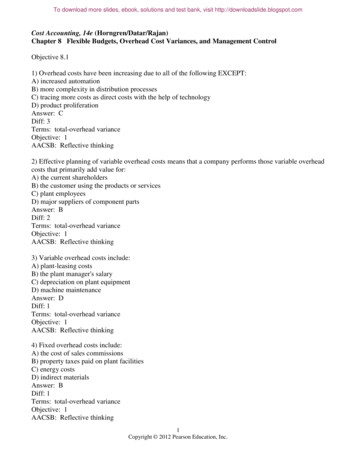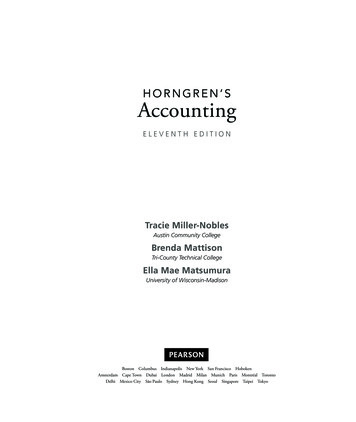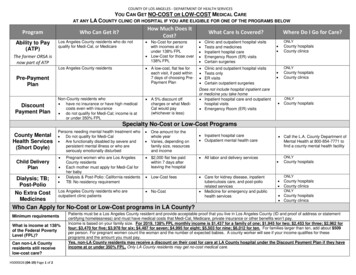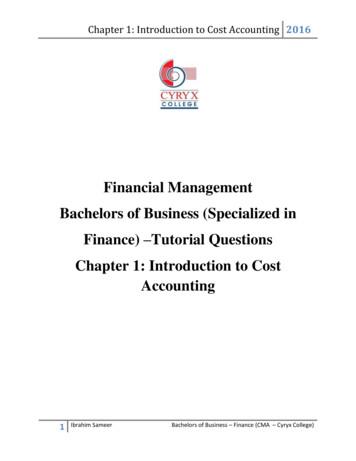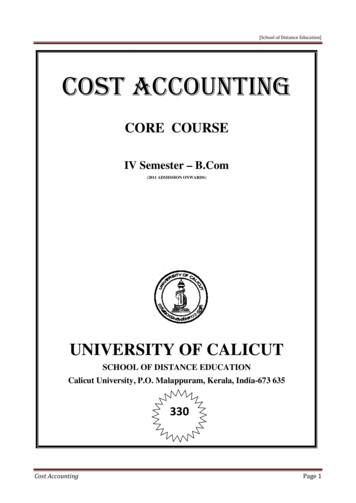
Transcription
Cost Accounting, 14e (Horngren/Datar/Rajan)Chapter 12 Pricing Decisions and Cost ManagementObjective 12.11) Companies should only produce and sell units as long as:A) there is customer demand for the productB) the competition allows itC) the revenue from an additional unit exceeds the cost of producing itD) there is a generous supply of low-cost direct materialsAnswer: CDiff: 2Terms: target priceObjective: 1AACSB: Ethical reasoning2) Too high a price may:A) deter a customer from purchasing a productB) increase demand for the productC) indicate supply is too plentifulD) decrease a competitor's market shareAnswer: ADiff: 1Terms: target priceObjective: 1AACSB: Reflective thinking3) Companies must always examine their pricing:A) based on the supply of the productB) based on the cost of producing the productC) through the eyes of their customersD) through the eyes of their competitorsAnswer: CDiff: 3Terms: target priceObjective: 1AACSB: Ethical reasoning4) Competitors:A) with alternative products can force a company to lower its pricesB) can gain a competitive pricing advantage with knowledge of your costs and operating policiesC) may span international bordersD) All of these answers are correct.Answer: DDiff: 2Terms: target priceObjective: 1AACSB: Reflective thinking1Copyright 2012 Pearson Education, Inc.
5) Fluctuations in exchange rates between different currencies can influence the:A) cost of products using foreign suppliersB) pricing of alternative products offered by foreign competitorsC) demand for products of foreign competitorsD) All of these answers are correct.Answer: DDiff: 2Terms: target priceObjective: 1AACSB: Multiculturalism and diversity6) The cost of producing a product:A) in highly competitive markets controls pricingB) affects the willingness of a company to supply a productC) for pricing decisions includes manufacturing costs, but not product design costsD) None of these answers are correct.Answer: BDiff: 3Terms: cost incurrenceObjective: 1AACSB: Reflective thinking7) In a noncompetitive environment, the key factor affecting pricing decisions is the:A) customer's willingness to payB) price charged for alternative productsC) cost of producing and delivering the productD) All of these answers are correct.Answer: ADiff: 3Terms: target priceObjective: 1AACSB: Reflective thinking8) In a competitive market with differentiated products like cameras, the key factor(s) affecting pricingdecisions is/are the:A) customer's willingness to payB) price charged for alternative productsC) cost of producing and delivering the productD) All of these answers are correct.Answer: DDiff: 2Terms: target priceObjective: 1AACSB: Reflective thinking2Copyright 2012 Pearson Education, Inc.
9) Three major influences on pricing decisions are:A) competition, costs, and customersB) competition, demand, and production efficiencyC) continuous improvement, customer satisfaction, and supplyD) variable costs, fixed costs, and mixed costsAnswer: ADiff: 1Terms: target priceObjective: 1AACSB: Reflective thinking10) Companies must always examine pricing decisions through the eyes of their customers.Answer: TRUEDiff: 2Terms: target priceObjective: 1AACSB: Ethical reasoning11) Companies that produce high quality products do NOT have to pay attention to the actions of theircompetitors.Answer: FALSEExplanation: No business operates in a vacuum. Companies must always be aware of the actions oftheir competitors.Diff: 2Terms: target priceObjective: 1AACSB: Reflective thinking12) Relevant costs for pricing decisions include manufacturing costs, but NOT costs from other valuechain functions.Answer: FALSEExplanation: Relevant costs for pricing decisions include costs from all value-chain functions, fromR&D to customer service.Diff: 2Terms: value-added costObjective: 1AACSB: Reflective thinking13) Prices are decreased when demand is weak and competition is strong and increased when demand isstrong and competition is weak.Answer: TRUEDiff: 3Terms: costObjective: 1AACSB: Reflective thinking3Copyright 2012 Pearson Education, Inc.
14) In markets with little or no competition, the key factor affecting price is the customers' willingnessto pay, not costs or competitors.Answer: TRUEDiff: 2Terms: value-added costObjective: 1AACSB: Reflective thinking15) When prices are set in a competitive marketplace, product costs are the most important influence onpricing decisions.Answer: FALSEExplanation: When prices are set in a competitive marketplace, companies have no control over settingprices and must accept the price determined by the market.Diff: 2Terms: target priceObjective: 1AACSB: Reflective thinking16) The only competition a firm must be concerned about when setting prices are those in the localmarket.Answer: FALSEExplanation: A firm must be concerned with local, national and even international competition whensetting a price.Diff: 2Terms: target priceObjective: 1AACSB: Reflective thinking17) Claudia Geer, controller, discusses the pricing of a new product with the sales manager, JamesNolan. What major influences must Claudia and James consider in pricing the new product? Discusseach briefly.Answer: The major influences are customers, competitors, and costs.Customers: Managers must always examine pricing problems through the eyes of their customers. Aprice increase may cause customers to reject a company's product and choose a competing or substituteproduct.Competitors: Competitors' reactions influence pricing decisions. At one extreme, a rival's prices andproducts may force a business to lower its prices to be competitive. At the other extreme, a businesswithout a rival in a given situation can set higher prices. A business with knowledge of its rivals'technology, plant capacity, and operating policies is able to estimate its rivals' costs, which is valuableinformation in setting competitive prices.Costs: Companies price products to exceed the costs of making them. The study of cost-behaviorpatterns gives insight into the income that results from different combinations of price and outputquantities sold for a particular product.Diff: 2Terms: target priceObjective: 1AACSB: Reflective thinking4Copyright 2012 Pearson Education, Inc.
Objective 12.21) Short-term pricing decisions:A) use costs that may be irrelevant for long-term pricing decisionsB) are more opportunisticC) tend to decrease prices when demand is strongD) have a time horizon of more than one yearAnswer: BDiff: 3Terms: target priceObjective: 2AACSB: Reflective thinking2) Relevant costs for pricing a special order include:A) existing fixed manufacturing overheadB) nonmanufacturing costs that will not change even if the special order is acceptedC) additional setup costs for the special orderD) All of these answers are correct.Answer: CDiff: 2Terms: cost incurrenceObjective: 2AACSB: Reflective thinking3) Which of the following factors should NOT be considered when pricing a special order?A) the likely bids of competitorsB) the incremental cost of one unit of productC) revenues that will be lost on existing sales if prices are loweredD) stable pricing to earn the desired long-run returnAnswer: DDiff: 3Terms: target priceObjective: 2AACSB: Reflective thinking4) A price-bidding decision for a one-time-only special order includes an analysis of all:A) manufacturing costsB) cost drivers related to the productC) direct and indirect variable costs of each function in the value chainD) fixed manufacturing costsAnswer: CDiff: 2Terms: cost incurrenceObjective: 2AACSB: Reflective thinking5Copyright 2012 Pearson Education, Inc.
5) For pricing decisions, full product costs:A) include all costs that are traceable to the productB) include all manufacturing and selling costsC) include all direct costs plus an appropriate allocation of the indirect costs of all business functionsD) allow for the highest possible product pricesAnswer: CDiff: 2Terms: cost incurrenceObjective: 2AACSB: Reflective thinkingAnswer the following questions using the information below:Black Forrest manufactures rustic furniture. The cost accounting system estimates manufacturing coststo be 240 per table, consisting of 60% variable costs and 40% fixed costs. The company has surpluscapacity available. It is Black Forrest policy to add a 50% markup to full costs.6) Black Forrest is invited to bid on a one-time-only special order to supply 200 rustic tables. What isthe lowest price Black Forrest should bid on this special order?A) 43,200B) 14,400C) 24,000D) 28,800Answer: DExplanation: D) 240 60% 200 tables 28,800Diff: 2Terms: cost incurrenceObjective: 2AACSB: Analytical skillsAnswer the following questions using the information below:Caruso Cool manufactures single room sized air conditioners. The cost accounting system estimatesmanufacturing costs to be 190 per air conditioner, consisting of 75% variable costs and 25% fixedcosts. The company has surplus capacity available. It is Caruso Cool's policy to add a 30% markup tofull costs.7) Caruso is invited to bid on a one-time-only special order to supply 50 air conditioners. What is thelowest price Caruso should bid on this special order?A) 9,500B) 7,125C) 12,500D) 12,350Answer: BExplanation: B) 190 75% 50 air conditioners 7,125Diff: 2Terms: cost incurrenceObjective: 2AACSB: Analytical skills6Copyright 2012 Pearson Education, Inc.
8) A medium sized motel chain is currently expanding and has decided to create more rooms and aircondition all of its rooms, which are currently not air conditioned. Caruso Cool is invited to submit a bidto the motel chain. What per unit price will Caruso Cool MOST likely bid for this special order of 50units?A) 190.00 per unitB) 142.50 per unitC) 247.00 per unitD) 250.00 per unitAnswer: CExplanation: C) 190 ( 190 30%) 247Diff: 2Terms: cost incurrenceObjective: 2AACSB: Analytical skillsAnswer the following questions using the information below:Rogers' Heaters is approached by Ms. Sushi, a new customer, to fulfill a large one-time-only specialorder for a product similar to one offered to regular customers. Rogers' Heaters has excess capacity. Thefollowing per unit data apply for sales to regular customers:Direct materialsDirect manufacturing laborVariable manufacturing supportFixed manufacturing supportTotal manufacturing costsMarkup (30%)Estimated selling price 40012060200780234 1,0149) For Rogers' Heaters, what is the minimum acceptable price of this one-time-only special order?A) 580B) 780C) 520D) 1,014Answer: AExplanation: A) 400 120 60 580Diff: 2Terms: target priceObjective: 2AACSB: Analytical skills7Copyright 2012 Pearson Education, Inc.
10) Before accepting this one-time-only special order, Rogers' Heaters should consider the impact on:A) current plant capacityB) long-term customersC) competitorsD) All of these answers are correct.Answer: DDiff: 2Terms: target priceObjective: 2AACSB: Analytical skillsAnswer the following questions using the information below:Gerry's Generator Supply is approached by Mr. Sandman, a new customer, to fulfill a large one-timeonly special order for a product similar to one offered to regular customers. Gerry's Generator Supplyhas excess capacity. The following per unit data apply for sales to regular customers:Direct materialsDirect manufacturing laborVariable manufacturing supportFixed manufacturing supportTotal manufacturing costsMarkup (20%)Estimated selling price 1,700.00100.00200.00150.002,150.00430.00 2,580.0011) For Gerry's Generators, what is the minimum acceptable price of this one-time-only special order?A) 1,800B) 2,000C) 2,150D) 2,580Answer: BExplanation: B) 1,700 100 200 2,000Diff: 2Terms: target priceObjective: 2AACSB: Analytical skills12) Before accepting this one-time-only special order, Gerry's Generators wants to know how muchprofit would be made on the order:A) 2,000B) Loss of 150C) 0D) 430Answer: CDiff: 2Terms: target priceObjective: 2AACSB: Analytical skills8Copyright 2012 Pearson Education, Inc.
Answer the following questions using the information below:Marcia Manufacturing is approached by a European customer to fulfill a one-time-only special order fora product similar to one offered to domestic customers. Marcia Manufacturing has a policy of adding a20% markup to full costs and currently has excess capacity. The following per unit data apply for salesto regular customers:Variable costs:Direct materialsDirect laborManufacturing overheadMarketing costsFixed costs:Manufacturing overheadMarketing costsTotal costsMarkup (10%)Estimated selling price 30101551002018036 21613) For Marcia Manufacturing, what is the minimum acceptable price of this one-time-only specialorder?A) 40B) 55C) 60D) 66Answer: CExplanation: C) 30 10 15 5 60Diff: 2Terms: cost-plus pricingObjective: 2AACSB: Multiculturalism and diversity14) What is the full cost of the product per unit?A) 60B) 180C) 198D) 66Answer: BExplanation: B) 30 10 15 5 100 20 180Diff: 1Terms: cost-plus pricingObjective: 2AACSB: Analytical skills9Copyright 2012 Pearson Education, Inc.
Answer the following questions using the information below:Ferryman Products manufactures coffee tables. Ferryman Products has a policy of adding a 20% markupto full costs and currently has excess capacity. The following information pertains to the company'snormal operations per month:Output unitsMachine-hoursDirect manufacturing labor-hours30,000 tables8,000 hours10,000 hoursDirect materials per unit 100Direct manufacturing labor per hour 12Variable manufacturing overhead costs 322,500Fixed manufacturing overhead costs 1,200,000Product and process design costs 900,000Marketing and distribution costs 1,125,00015) Ferryman Products is approached by an overseas customer to fulfill a one-time-only special orderfor 1,000 units. All cost relationships remain the same except for a one-time setup charge of 20,000.No additional design, marketing, or dis
Chapter 12 Pricing Decisions and Cost Management Objective 12.1 1) Companies should only produce and sell units as long as: A) there is customer demand for the product B) the competition allows it C) the revenue from an additional unit exceeds the cost of producing it D) there is a generous supply of low-cost direct materials Answer: C Diff: 2 Terms: target price Objective: 1


